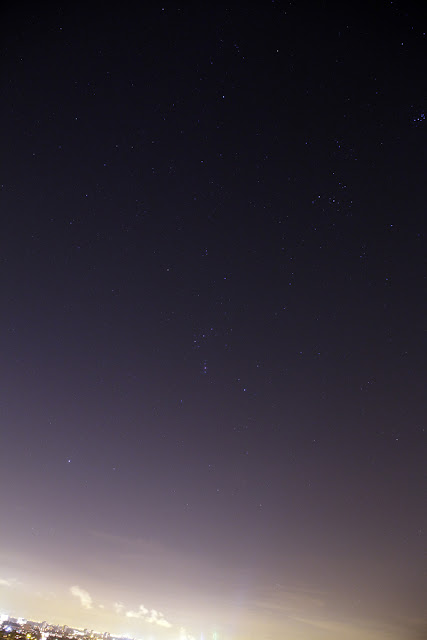Recently a friend of mine made an adapter for me that enables me to fit my "old" Mamiya 645 medium format lenses on my "modern" ST-8300M CCD-camera. Because of the large flange focal distance of the Mamiya 645 lenses, there remains enough space to fit a filter wheel between the lens and the camera.
On the evening of January 31, 2012, I've tried out the adapter and it works! The adapter has been made a little shorter than calculated to be sure that the lenses can be focused in combination with filters in the light path. Instead of rotating the lens to the infinity mark, the lens has to be focused on a bright star (or object on the horizon).
First light was with a 45 mm f/2.8 lens and 7 nm H-alpha filter. The camera and lens were mounted on my Vixen Photoguider.
I took 12 images of 5 minutes each (unguided and rough polar alignment). Two images were wasted due to guiding errors, so here is 50 minutes of Barnard's Loop in Sweet Lake City's light pollution soup.
Tuesday, 31 January 2012
Saturday, 28 January 2012
City Astronomy
Dutch Astronaut André Kuipers took an image of the Netherlands (and Belgium) from space.
I live in the centre of the red cross hair: one of the most light polluted areas of the Netherlands. The bright yellow spots are caused by assimilation lights of greenhouses.
What does this mean for (amateur) astronomy? Well, kids who grow up in this part of the Netherlands cannot experience the splendour of the milky way. Most kids don't even know the existence of it, until they go on a holiday to a "dark" place. It also means that taking a picture of the Orion constellation with an exposure time of 2 minutes will lead to an overexposed image. The image below was exposed for 10 seconds at ISO 1600 with a Canon 5D Mark II and Canon EF 24-70 mm f/2.8 L USM lens at 25 mm f/5.6.

The only celestial objects in the sky that don't get disturbed by light pollution are the moon and planets. The following picture was taken on the same evening (January 27, 2012) at the public astronomical observatory of Rijswijk, located on top of a 12 storey high apartment building. You can see Jupiter on the top left and the moon and Venus at the lower right. On the foreground, a fellow astronomer is taking pictures of this conjunction. The high antennas are lightning rods. Exposed for 2.5 seconds with the same camera and lens at 24 mm f/5.6 and ISO 1600.
When the moon set, it disappeared in the clouds. Again taken with the same camera, but with a Mamiya 210 mm Sekor-C f/4 lens. Exposed for 4 seconds at f/8 and ISO 1600.
I live in the centre of the red cross hair: one of the most light polluted areas of the Netherlands. The bright yellow spots are caused by assimilation lights of greenhouses.
What does this mean for (amateur) astronomy? Well, kids who grow up in this part of the Netherlands cannot experience the splendour of the milky way. Most kids don't even know the existence of it, until they go on a holiday to a "dark" place. It also means that taking a picture of the Orion constellation with an exposure time of 2 minutes will lead to an overexposed image. The image below was exposed for 10 seconds at ISO 1600 with a Canon 5D Mark II and Canon EF 24-70 mm f/2.8 L USM lens at 25 mm f/5.6.

The only celestial objects in the sky that don't get disturbed by light pollution are the moon and planets. The following picture was taken on the same evening (January 27, 2012) at the public astronomical observatory of Rijswijk, located on top of a 12 storey high apartment building. You can see Jupiter on the top left and the moon and Venus at the lower right. On the foreground, a fellow astronomer is taking pictures of this conjunction. The high antennas are lightning rods. Exposed for 2.5 seconds with the same camera and lens at 24 mm f/5.6 and ISO 1600.
When the moon set, it disappeared in the clouds. Again taken with the same camera, but with a Mamiya 210 mm Sekor-C f/4 lens. Exposed for 4 seconds at f/8 and ISO 1600.
Subscribe to:
Comments (Atom)





